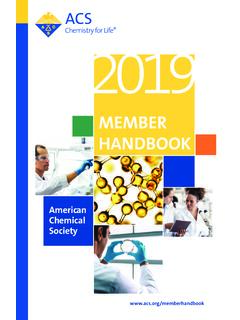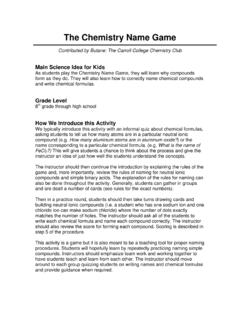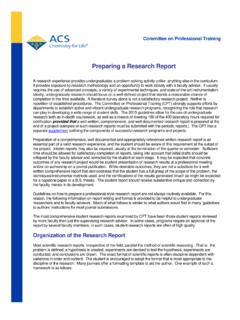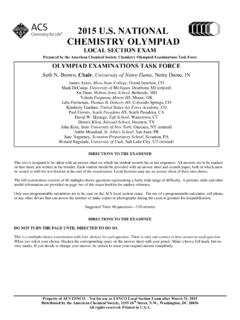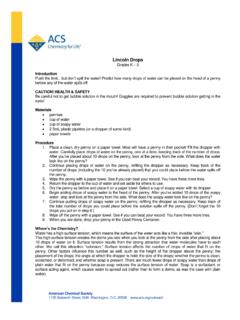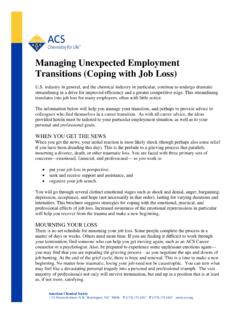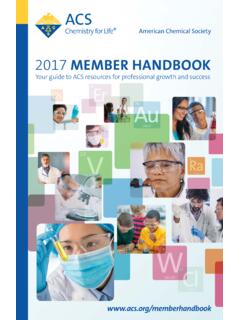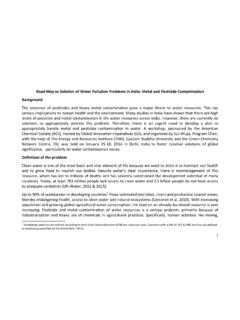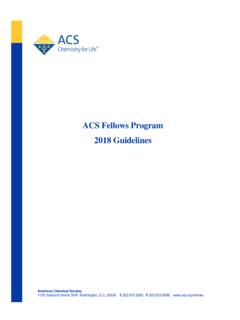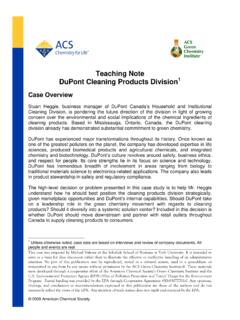Transcription of Safety in Academic Chemistry Laboratories
1 Safety in Academic Chemistry Laboratories8TH EDITIONBEST PRACTICES FOR FIRST- AND SECOND-YEAR UNIVERSITY STUDENTSA Publication of the American chemical Society Joint Board Council Committee on chemical SafetyCopyright 2017 American chemical Society1155 Sixteenth Street, NWWashington, DC 20036 All rights 978-0-8412-3732-2 Printed in the USAAMERICAN chemical SOCIETYS afety in Academic Chemistry Laboratories8TH EDITIONBEST PRACTICES FOR FIRST- AND SECOND-YEAR UNIVERSITY STUDENTS2 Foreword from the Chair At a time when there was little emphasis on teaching laboratory Safety , the Committee on chemical Safety of the American chemical Society (ACS) published the first edition of Safety in Academic Chemistry Laboratories (SACL).
2 Now, more than four decades later, SACL has undergone seven revisions, is printed in three languages, and is one of the most widely used laboratory Safety guidance documents in print and online. Although it was initially written for Academic Chemistry Laboratories , its infor-mation and application of safe practices can be extended to all Laboratories , research facilities, and workplaces where chemicals are time, we have become more aware of the hazards and risks associated with laboratory chemicals and have sought to share this new information. The Committee, along with the ACS Division of chemical Health and Safety , dissem-inates current materials, practices, and research developments through technical programming at national and regional meetings, articles in its Journal of chemical Health and Safety , and publishing guidance documents for Academic and industrial institutions.
3 After several Academic laboratory accidents, the Committee recognized a great need for improved Safety education in all Academic environments. A task force generated Creating Safety Cultures in Academic Institutions,1 a guidance document 1 ACS Joint Board/Council Committee on chemical Safety . Creating Safety Cultures in Academic Institutions: A Report of the Safety Culture Task Force of the ACS Committee on chemical Safety ; American chemical Society: Washington, DC, 2012. Committee on chemical Safety . Guidelines for chemical Laboratory Safety in Academic Institutions; American chemical Society: Washington, DC, 2016. Committee on chemical Safety . Guidelines for chemical Laboratory Safety in Secondary Schools;American chemical Society: Washington, DC, 2016.
4 ACS Committee on chemical Safety . chemical Safety in the Classroom. to improve the Safety culture in these institutions. To assist academia in strengthening the education aspect of Safety , the Committee generated several additional guidance documents. Guidelines for chemical Laboratory Safety in Academic Institutions2 integrates Safety education throughout the entire curriculum for all levels of Chemistry using a novel acronym system. Precollege (high school and middle school) science educators include chemical Safety in the curriculum by following Guidelines for chemical Laboratory Safety in Secondary The Committee also provides two publications to assist elementary science teachers with Safety education.
5 Copies of Safety in the Elementary (K 6) Science Classroom and chemical Safety for Teachers and Their Supervisors: Grades 7 12 are available through the ACS by request at Additional Safety resources are available through download at behalf of the Committee on chemical Safety , I am pleased to introduce this eighth edition of SACL. I thank all the contributors who generously contributed their time, talents, and expertise to this and previous editions of this outstanding publication. Their efforts make the Academic laboratory a safer place in which to work and learn. A special thank you goes to David C. Finster, who served as Editor and chief contributor for this edition (SACL-8). The comprehensive revisions and new sections are a direct result of his commitment and dedication to chemical Safety education.
6 The Preface from the Editor acknowledges those who contributed to this edition and previous revisions. Marta Gmurczyk coordinated the ACS staff members involved in the production and distribution of comments are welcome. Please direct them to the ACS Committee on chemical Safety at M. HowsonChair, ACS Committee on chemical Safety March 2017 Images used in this publication are from Shutterstock unless otherwise from the EditorThe first edition of Safety in Academic Chemistry Laboratories (SACL) was written in 1972 by members of the ACS Committee on chemical Safety (CCS) under the direction and urging of its chair, Howard H. Fawcett. It was published as an 11-page, double-spaced, typed and mimeographed document.
7 Since then, more than a million copies of the first seven editions of SACL have been distributed. Throughout the intervening years, the field of chemical health and Safety has evolved considerably, although some basic concepts remain unchanged. This current edition represents the current best practices in Academic laboratory purpose of this booklet (SACL-8) is to provide an overview of the key issues related to the safe use of chemicals in the first two years of an undergraduate program in Chemistry . Some information of a more advanced nature has been pruned, because delving into these topics would have considerably increased the size of the booklet 5and because the primary use of this booklet has been and continues to be for topics appropriate for first- and second-year college students.
8 This change is reflected in the title, along with the focus on a positive Safety culture with the phrase best practices .Much from previous editions has been retained. Some changes from SACL-7 include: A new title, to reflect that the booklet has been revised to target Safety concerns encountered by first- and second-year college students in general Chemistry and organic Chemistry Laboratories . A new introduction that sets basic laboratory Safety information in the context of developing a culture of Safety in chemical Laboratories . A review of common personal protective equipment and various Safety practices in Laboratories . A guide to chemical hazards, how to recognize them, and sources of information about chemical hazards, including the GHS.
9 An overview of Safety concerns for many common laboratory techniques. An overview of Safety equipment and emergency response procedures for fires, spills, and chemical exposures. The addition of sidebars, for interest and readability, and In Your Future sections for common Laboratories hazards and concerns that are less likely to be encountered in introductory and organic Laboratories but about which all students should be aware. A content shift from Safety based primarily on rules to learning about Safety through the RAMP list of individuals who have contributed to SACL-8, and all previous editions, is too long to include here in its entirety. It is appropriate, however, to note the contributions of Jay Young (1920 2011) over the span of decades, including the first edition.
10 This is but one of his many long-lasting contributions to the world of chem-ical Safety . For this edition, the primary authors have been Georgia Arbuckle-Keil, Robert H. Hill, Jr., Samuella Sigmann, Weslene Tallmadge, and myself. Debbie Decker, Harry Elston, and Ed Movitz provided technical reviews. Thanks to Karen M ller, who provided editorial services, Amy Phifer of Plum Creative Services, who designed this new edition of the publication, and Marta Gmurczyk (ACS staff liaison to the CCS), who coordinated the ACS staff members involved in the production and distribution of C. FinsterEditor March 20171 Hill R. H., Finster D. C. Laboratory Safety for Chemistry Students, 2nd ed.; John Wiley & Sons: Hoboken, NJ, The materials contained in this manual have been compiled by recognized authorities from sources believed to be reliable and to represent the best opinions on the subject.
